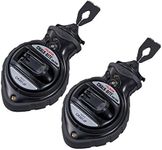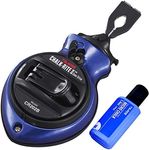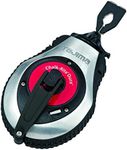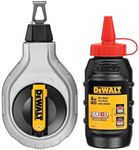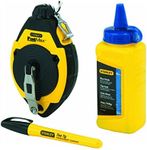Buying Guide for the Best Chalk Lines
Choosing the right chalk line can make your marking tasks much easier and more accurate, whether you're working on construction, carpentry, or DIY projects. Chalk lines are simple tools, but there are a few important features to consider to ensure you get one that fits your needs. Understanding these key specifications will help you select a chalk line that is reliable, easy to use, and suitable for the types of projects you plan to tackle.Line LengthLine length refers to how much string is wound inside the chalk line tool. This is important because it determines how long a straight line you can mark in one go. Chalk lines typically come in lengths ranging from about 30 feet to 100 feet or more. Shorter lines (around 30-50 feet) are easier to handle and rewind, making them great for smaller projects or indoor use. Longer lines (over 50 feet) are better for large outdoor projects or when you need to mark long distances, but they can be bulkier and a bit harder to manage. Think about the typical size of your projects—if you mostly work on small rooms or furniture, a shorter line is usually enough. For bigger construction or landscaping jobs, a longer line will be more useful.
Line ThicknessLine thickness is about how thick the string is that holds the chalk. Thicker lines leave a bolder, more visible mark, which is helpful for outdoor work or rough surfaces, but they can be less precise. Thinner lines make finer, more accurate marks, which is better for detailed carpentry or finish work. If you need your lines to be highly visible and don't mind a bit of extra width, go for a thicker line. If you need precision and clean lines, a thinner string is the way to go.
Chalk CapacityChalk capacity tells you how much chalk powder the tool can hold. A larger capacity means you can mark more lines before needing to refill, which is convenient for big jobs. Smaller capacities are lighter and easier to carry, but you'll need to refill more often. If you do a lot of marking in one session, a higher capacity is helpful. For occasional or light use, a smaller capacity is usually sufficient.
Case MaterialThe case material is what the outer body of the chalk line is made from, usually plastic or metal. Metal cases are more durable and can withstand rough handling, making them a good choice for heavy-duty or outdoor work. Plastic cases are lighter and often less expensive, which is fine for light or occasional use. If you expect your tool to take some knocks or be used in tough environments, a metal case is a safer bet. For home or light use, plastic is usually adequate.
Reel MechanismThe reel mechanism is how you wind the string back into the case. Some chalk lines have a simple manual crank, while others have a faster gear system or even automatic rewind. Faster or automatic reels save time and effort, especially if you use the tool a lot. Manual cranks are more basic but are less likely to break. If you value speed and convenience, look for a faster or automatic reel. If you prefer simplicity and reliability, a manual crank is a good choice.
Hook DesignThe hook is the small metal piece at the end of the line that attaches to surfaces. Some hooks are basic, while others have features like extra grip or the ability to attach to nails or screws. A more versatile hook can make it easier to use the chalk line in different situations, especially on uneven or tricky surfaces. If you often work alone or in challenging spots, a hook with extra features can be very helpful. For simple, flat surfaces, a basic hook will do the job.


